Products recommended in this post contain affiliate links. If you buy something through our posts, we may receive a commission at no extra charge to you. See our full disclosures here.
You have decided that you want to have a tropical freshwater fish tank and get started with the wonderful hobby keeping aquatic pets. That's great! But you don’t know what equipment you need to prepare as well as how to properly set up a freshwater aquarium to ensure all your new fish happy and healthy. Don't worry! this article is all you need for the process.
Firstly, plan for the fish you want to stock
Before you start ordering a ton of stuff online or rushing to the store, there are many factors to consider. First of all, you should plan for the fish stocking before buying anything for the new tank. The types and number of fish you want to keep will decide on the fish tank size as well as equipment you will need for the setup.
Do you want a peaceful community tank?
A peaceful community tank is a great option for beginners. You will have an amazing variety of fish to choose from without having to worry quite as much about compatibility. At least the consequences for putting the wrong fish together are typically not as severe as if you were to put the wrong aggressive fish together.
The best candidates for freshwater community tanks are:
- Livebearers: Guppies, Swordtails, Mollies, Platies...
- Tetras: Cardinal Tetras, Neon Tetras, Glowlight Tetras, Bleeding Heart Tetras, Black Skirt Tetras, Rummy Nose Tetras...
- Rasboras: Harlequin Rasbora, Scissortail Rasbora, Axelrod Rasbora, Emerald Eye Rasbora...
- Danio fish: Zebra Danio, Glowlight Danio, Gold Danio, Long Finned Danio, Leopard Danio...
- Cory catfish, Plecos...
- Snails and shrimps: Apple snails, Nerite snails, Assassin snails, Yellow shrimps, Amano shrimps, Red Cherry shrimps...
Do you want a semi-aggressive or aggressive tank?
If you are more inclined to keep semi-aggressive or aggressive fish, I have some great suggestions for those setups as well. Cichlid tanks are some of my personal favorite setups and there is an absolutely huge variety to choose from. If you have a large enough aquarium and are very cautious about your fish selection, an aggressive multi species tank can be an option.
After deciding on the type of fish you want to keep, you just need to select a tank size to appropriately house your fish. You need to get a tank that is big enough to accommodate all of the fish you plan for. Generally, you need 1 gallon of water for every 1 inch of fish. This rule is not entirely accurate; however, until your tank is established this is an excellent end goal to follow.
How to choose a right fish tank?
If you have specific fish in mind, make sure the tank you use is going to be large enough to accommodate them. Use the thumb rule "1 inch of fish per 1 gallon of water" to determine the aquarium size you need.
- 2.5-3 gallon fish tank - just enough for one male Betta fish happy and healthy
- 5 gallon fish tank - ideal as a shrimp or Betta tank setup
- 10 gallon fish tank - best house for one male Betta with some tank mates, small tropical fish and shrimps
- 20 gallon fish tank - ideal for starters who don't have much experience for solving aquarium problems
- 29-30 gallon fish tank - another good choice for starters
- 50-55 gallon fish tank - great for saltwater fish or large body freshwater fish such as Koi, Goldfish, Cichlids...
I strongly recommend that you DO NOT start out with anything smaller than a 20 gallon aquarium. Somewhere between 30 and 75 gallons is going to be best for your aquatic pets. The reason is that fish waste and uneaten food will produce ammonia. In a very small tank these ammonia levels build up faster and easily poison your fish. That is the reason why smaller tanks are more difficult to stabilize than larger ones.
It is a good idea to pick something that is bigger in the length and width dimensions than height in most cases. Fish tend to swim horizontally not vertically. However, the height can benefit you if you have fish in a community because different types of fish will swim at different depths. For example, catfish and bichir hang out on the bottom, arowana swim at the surface.
Choose a proper location to place the tank
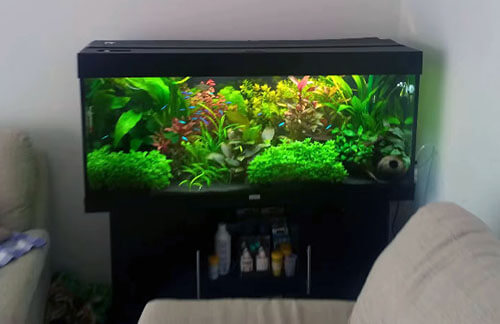
Water is heavy (about 8.5 pounds per gallon) so first of all make sure the spot you choose can support the weight of your aquarium. Also, you will not want to move it. When it is full of water you won’t be able to and even if you were to empty most of the water, a lot of it stays in your gravel or sand (also heavy even when dry).
- Try to pick a spot that isn't going to have a ton of direct sunlight. Most importantly direct sunlight is going to promote annoying algae growth.
- Make sure your spot is level. The reasons for this should be obvious. (shouldn’t be an issue in most homes anyways.)
- I recommend that you choose somewhere along a wall and avoid corners. There are some really nice looking options for corners but you have a much better selection of tank sizes in standard rectangular shapes as well as a lot of good bow front rectangular tanks.
How to choose aquarium supplies?
Fish tank stand

First of all, we must consider what the fish tank is to stand on. Water is quite heavy – 8.3 pounds per U.S. gallon. Thus a 15-gallon fish tank weighs about 125 pounds. This is certainly no weight for a delicate end table to support. The base for a fish tank must be a sturdy one - flat and level. Any projections, tilt, or unsteadiness may cause leakage. The location should be a fairly permanent one. Fish tanks cannot be moved readily.
Also, the height must be considered. It should be high enough to be seen standing up and low enough to be viewed comfortably while sitting down. An ideal height for a stand is 30 to 36 inches. Stands expressly designed for supporting aquariums are available. Most of these are equipped with a shelf which can be used for an auxiliary tank or for equipment.
Filtration system

A filter cleans your tank water, and is essential to the well-being and survival of your fish. Having a filter is not about taking the workload off of you or allowing you to skip off on maintenance more than a tank without one, these are just luxurious side benefits. The true purpose of a filter is to establish a biochemical balance within your aquarium that fish would die without.
To select a filter, I highly suggest you to read my aquarium filter guide about various types of filters available on the market today. If you're just starting out or need to start on a budget, a power filter (internal or external) is a safe bet. Following are the best filters rated by gallons recommended by Love Fish Tank.
- 3-5 gallon aquarium filter
- 10 gallon aquarium filter
- 20 gallon aquarium filter
- 29-45 gallon aquarium filter
- 50-60 gallon aquarium filter
- 70-80 gallon aquarium filter
Lid or Hood

Usually lids are sold with the light and are referred to as the hood or canopy. The lid covers the tank to keep other pets out, to keep the fish from jumping out, to cut down on evaporation and to hold the light in place. They are made of glass or plastic. The plastic hoods cost less, are light weight and are less breakable than the glass lids. While glass lids are easier to clean and provide a tighter fit over the tank. Understand that the better the fit, the less evaporation you will have, so make sure whatever type of lid you buy it fits the tank well.
Find your aquarium hood here: http://lovefishtank.com/best-aquarium-hood/.
Aquarium LED light and timer

Fish need light for their activities, aquatic plants and corals use light for photosynthesis, which is essential for their vitality. The light is usually packaged with the lid if you buy a full aquarium kit; however, if your one doesn’t include any, you may want to purchase the light separately. Based on the type of your aquarium, you will need a proper light to support the life of all organisms living in the tank. I divide aquarium lights into three types:
10-12 hours of lighting is ideal for an aquarium and the using of a timer helps to turn the light on/off automatically. Some LED lights today come with a built-in timer; however, you can buy this equipment separately.
Aquarium heater and thermometer

A heater isn’t usually included in an aquarium package but you will need one unless you plan on only having cold water fish, like gold fish. If you decide to go with a tropical tank, it is necessary for you to buy a heater. You should aim for 76-80 degrees for your tropical tank as a general guideline and a thermometer is very helpful to daily monitor the water temperature. Keep the temperature steady and your fish will thank you for it.
Fully submersible heaters are popular choice for aquarium these day, they are very easy to use and can be placed anywhere in the tank with suction cups. There is a complete guide for choosing the right heater by wattage as well as some basic rules you should know to handle with an aquarium heater in this article: http://lovefishtank.com/aquarium-heater/
Substrate
Substrate is the term given to the material which layers the bottom of your tank. Examples of this may be sand, soil, gravel, etc. Substrate is important for providing an anchor for plants and decorations, and promoting the growth of the beneficial bacteria that will keep your water clean. Aquarium gravel is recommended for the beginner and comes in many colors. Aquarium sand (not coral sand) can also be used in a freshwater setup, but is harder to clean.
First, research your fish species to determine if any of them sift through the substrate as a natural foraging behavior. If this is the case, a fine substrate such as sand or soil may be your the best choice. Otherwise, you may use your personal preference. Typically, dark substrates tend to make fish “pop” more. It helps relieve stress levels and actually enhances their pigmentation to make them appear more colorful. For fish without much color, their patterns are enhanced.
Decorations and plants
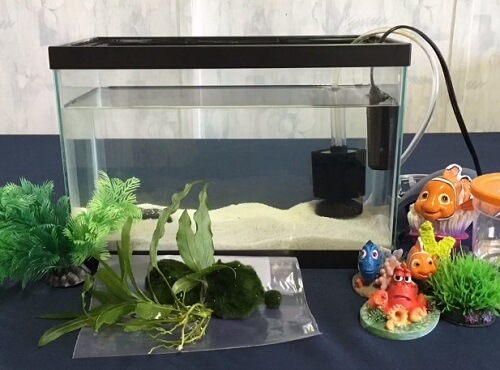
Choosing decorations for your aquarium is just as important as any other component. These will not only determine the aesthetic value of your aquarium to those who look at it, but they provide comfort and safety for the fish inhabiting it. Making your fish feel secure will help enhance their color, behavior, and reduce stress level. Typically, the more hiding spots you provide and the safer you aim to make your fish feel, the less they feel the need to hide.
Decorate to the behavioral traits of your fish. Active species such as danios or rainbowfish will need a good amount of open area to swim, while others such as the Malabar Dwarf Pufferfish prefer to have a heavily planted habitat. At this point, you should also make the decision for your tank to have either live or fake plants in it. Basic aquascaping principles call for taller items to be towards the back of the tank with shorter items being in the foreground and middle of the aquarium. Again, have an idea in your mind before randomly jamming ornaments into the tank. If you’re using live aquarium plants, plant these with only a couple inches of water in the tank before filling it up. This will make planting delicate species infinitely easier than if the tank was full (trust me, save yourself the headache and frustration).
Water conditioners
If you use a municipal water source that has a treatment facility, it is likely the water goes through some sort of chemical treatment and sterilization. While this is acceptable for human intake, it is not safe for our aquatic friends. Therefore, if you have even a slight suspicion that this is the case, get a conditioner. Choose those which state on the label to remove chlorine and chloramines from water. Seachem prime is one of the highest quality water conditioners in the market.
Other supplies to maintain a fish tank
- Water test kits to monitor water parameters, like ammonia, nitrites, and pH
- Nutritionally-balanced fish foods to feed your fish
- A fish net to transfer fish into/out of the tank
- A bucket in which to drain the dirty water during water changes, and from which to drain clean water back into the tank
- A glass scraper or magnet cleaner is also highly recommended if you want to keep the glass algae-free and looking good
- An aquarium gravel cleaner (siphon or vacuum water changer) to do water changing
- Aquarium air pump to aerate your fish tank and operate action decorations or some types of filters such as undergravel filter, sponge filter, corner filter...
- Automatic fish feeder to feed your fish when you are away.
How to set up a tropical freshwater fish tank?
Once you set up your tank it will be difficult to make changes so you should be sure to set it up correctly the first time. Below you will find a step-by-step guide for setting up your new tank:
Step 1 – Get your stand positioned
- Assemble your aquarium stand or cabinet – be sure to follow the instructions because once the tank is full it will weigh several hundred pounds so it must be very sturdy,
- Get your stand positioned where you want it,
- Make sure it is as level as possible.
Step 2 – Position your tank on the stand

- Clean your tank thoroughly with clean tap water. Place your tank on top of the stand or cabinet, centering it for the best balance and support.
If you are using a HOB power filter, hang it on the tank to make absolutely sure you have enough room between the tank and the wall. (Nothing worse than getting your tank filled with water to realize you don’t have room for your filtration. Remember, water weighs about 8.5 lbs/gal. So you would have to drain the entire tank in order to move it.)
Step 3 – Add the gravel to the tank
Pour your chosen aquarium gravel into your 5 gallon bucket, about 1/4 to 1/3 full. Spray the gravel in the bucket with a hose until the water level is about 3/4 of the way full, pressure is a good thing if you have a decent attachment for your hose.
Stir the gravel up really well with your hands and dump the dirty water out. Repeat this process until the water is clear. The cleaner the water is coming out of that bucket, the less cloudy your tank will be when you fill it up.

- Add the gravel to the tank. I personally am not a big fan of undergravel filtration; however, if you are using an undergravel filter make sure to have that in place before this step.
Step 4 – Rinse your decorations/plants and put them in place
Rinse your decorations and/or plants, and then placing them in whatever locations you desire. Be sure not to concentrate too many decorations in the middle of the tank because your fish need plenty of swimming space. This is the fun part and really the part that allows the most creativity on you. So take your time and make sure it looks good to you.

You can fill one-third of the tank with tap water for easily plating live plants and prevent them from dry and dead. You can also use some tools for aquarium planting in this step.
Although you can adjust and change the decorative layout after you fill the tank, it is best to keep your hands out of the water as much as possible. If you need to adjust after you fill it up, try to use a clean spatula or tongs if you can; just something to minimize the amount of time your hands are in the water.
Step 5 – Fill the tank up & add water conditioner
Fill the rest of aquarium way with tap water, if you bought the awesome vacuum hose that I mentioned in the supply list you use it for this work.
Be sure to fill the water slightly, the force of fast flowing water will destroy the layout of decorations you have worked so hard on. It can also damage any live plants you have placed as well as stirring up the gravel. Your aquarium will more than likely be cloudy after you fill it no matter what but filling to quickly will stir things up and only make matters worse. Everything will settle, the cloudiness will go away.

Treat the aquarium water with a dechlorinator to remove chlorine and other harmful chemicals. Your bottle of water conditioner will have specific directions as to the conditioner to gallons of water in your aquarium ratio to use. To make things really easy for you, the cap will have lines to measure your conditioner!
Step 6 – Install your aquarium equipment
Firstly, start and test your filter: One more thing to keep in mind, with some hang on back filters you will hear the motor hum when you plug it in but you will not have any water flow. If this is the case, unplug it and fill the reservoir of the filtration unit with water, then plug it back in. Your filtration should now be operational. You can now unplug it and set up other equipment for safety.
Set up your heater: Adjust the heater to the optimal temperature for your fish. For tropical fish, it is 74 and 80 degrees Fahrenheit (23 to 27 degrees Celcius). Placing the heater close to the water flow from the filter where the water is moving and will do a better job of heating the tank evenly.
Install the rest aquarium equipment including lighting system, air pump... Then, plug in your filter, heater, air pump… and start them up.
Step 7 – Cycle your new setup aquarium
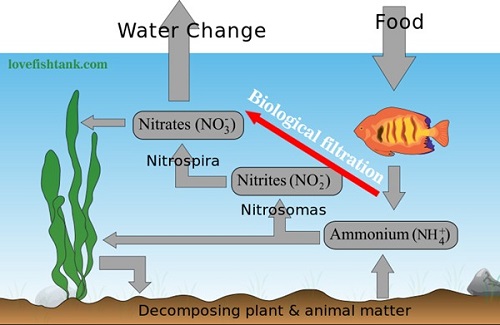
Aquarium nitrogen cycle
This step is for accumulating nitrifying bacteria that will later deal with toxic ammonia and nitrites from fish waste. The mechanism of this process is very simple to understand. You will need to propagate helpful nitrifying bacteria on your aquarium filter materials and substrate as much as well.
You will need ammonia and a starting bacteria culture to kick start the process.
[amazon box="B006MP4QG6,B006YG12F6" template="list"]
You can cycle your new aquarium with a few small, hardy freshwater fish but a much better way is to do a fishless cycle using commercial ammonia. A starting bacteria culture can be obtained from a small amount of gravel or filter media obtained from an established tank, or commercial preparations for aquarium uses. I strongly recommend the DrTim's Aquatics Ammonium Chloride (ammonia source) and API Quick Start Aquarium Nitrifying Bacteria.
[amazon box="B000255NCI" template="horizontal"]
After adding ammonia and a bacteria culture to your tank, add nothing but test ammonia, nitrite and nitrate levels (preferably daily). The API Freshwater Master test kit with pH, high range pH, ammonia, nitrite, nitrate tests is an economical option for both aquarium setup and maintenance.

Ammonia will spike first. Do not be surprised if it exceeds several parts per million. Since the tank has no livestock, this is not a problem and is a normal part of the process. When ammonia starts dropping, nitrite will climb. When it starts dropping, nitrate will climb. Do not be surprised if your tank does not perfectly follow this pattern. When ammonia and nitrite hit zero and nitrates are present, your tank is cycled.
This process usually lasts at least a month until you can safely add some fish to the tank. If you want to have several fish in your aquarium after setting up it but not wait for up to a month, try the method to aquarium cycling with hardy starter fish.
Every time you add a new animal to the tank, the ammonia output increases and the bacteria must reproduce to meet the increased demand and return to equilibrium. In a mature tank, this process can be completed in hours. In a newly-cycled tank, it will take longer, possibly days or weeks. So, you should buy and add your fish in many times to acclimate your new setup aquarium with the slowly increasing population.
Read more about aquarium nitrogen cycle and the method to aquarium cycling with hardy fish: http://lovefishtank.com/new-fish-tank-nitrogen-cycle/.
Top Editor's Choice on Freshwater Fish Tank
[amazon bestseller="Freshwater Fish Tank" filterby="price" filter="30" filter_compare="more" filter="available" orderby="percentage_saved" order="desc" template="list" items="10" tracking_id="tnk0c-aawp-cro-b-20"]Subscribe to our Newsletter!
Join our mailing list to receive the latest tips and news of our blog.


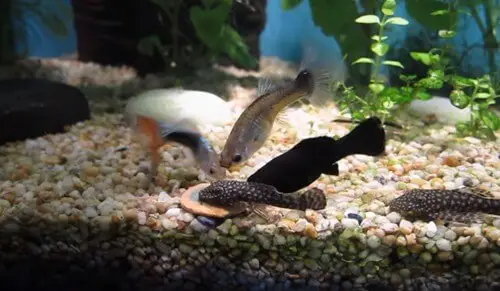
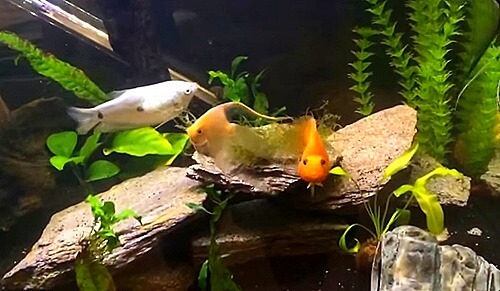
I have a love fish 40L tank, how do I set up the filter? I have no instructions, does it go inside or outside
I’m confused please help
Do you mean Love Fish panoramic 40L aquarium? If yes, you will need a filter for 10 gallon tank, an internal filter will perfectly fit into the tank. Find a 10 gallon aquarium filter here